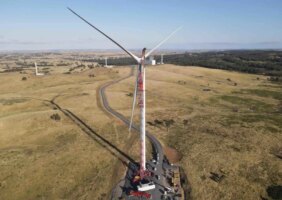If someone you trust were to tell you that something big and bad is about to happen, what would you do?
If you’re like me, you would try to get more information. If that were not forthcoming, you might stock up on essentials (no, toilet paper, that does not include you), make sure you have some cash and fuel (this is Australia, so for now we can forget about the widespread adoption of EVs), charge up, batten down the metaphorical hatches and hunker down with your loved ones to await your fate.
In 2020, this has been more than a hypothetical exercise. From cyclones and pandemics to wars, as a species we are pretty good at adapting to short-term crises (POTUS 45’s problem with the recent election result being an obvious exception).
Long-term threats to the global commons, not so much.
In the electricity sector, thinking about long-term resilience rather than short-term reliability is relatively new. The obvious tendency is to apply the tools we have to developed to solve past problems to emerging ones as well. This doesn’t always work.
Severe weather events are a case in point. If a network wants to invest to maintain reliability in the face of, say, an increase in bushfire or cyclone risk, the guidelines from the regulator (the AER) propose a simple formula: identify a reasonable scenario, calculate the consequence, weight by probability and choose the lowest cost solution.
This works for scenarios to which we can assign a probability with some confidence. In the case of climate risks, it works for single risks like heat and dryness/drought. Some combinations (“compound events”) can be assigned a probability with relatively high confidence.
Large bushfires, which typically occur through a combination of dryness, heat and strong winds, are a good example.
Even putting aside the uncertainty caused by different emissions reduction pathways, a probabilistic approach tends not to work in the case of other extreme or compound events, though. The three severe storms which hit Sydney over the summer of 2019-20 are a good example.
While extreme wind events from East Coast Lows are relatively common, in that case the damage was exacerbated not only by these lows being clustered with seasonal storms and associated lightning strikes, but also by tree roots having been weakened during years of drought, making the trees more likely to fall over and bring down power lines.
It is statistically very difficult to predict how likely a combination of factors like those is to occur in any given year and area.
The difficulty of predicting extreme and compound event is not new, but it is exacerbated by climate change. Some extreme and compound weather events are clearly linked to climate trends, some are not.
Here’s the rub: in a world which is increasingly likely to trip climate tipping points, triggering feedback loops with largely unknown consequences, there are too many unknowns to make meaningful statements about the probability of a range of events with potentially serious consequences.
In other words, how do we plan for an increasingly chaotic future?
This is a problem which has been occupying the minds of the crew engaged in the Electricity Sector Climate Information (ESCI) project, a collaboration between the Bureau of Meteorology, CSIRO and AEMO, funded by the federal government.
It is intended to improve the reliability and resilience of the National Electricity Market to the risks of climate change and extreme weather.
Their proposed solution is to use a range of plausible case studies to inform decision-making. The unusual but increasingly realistic combination of factors leading to the damage caused by the Sydney storms might be an example.
Case studies are used extensively to explore disaster impacts in operational and disaster management contexts.
This approach is consistent with recommendations in other jurisdictions and emerging from similar projects exploring financial and insurance risk management processes, and will likely be required for all corporations as part of the Taskforce for Climate Related Financial Disclosure (TCFD).
Basically, the idea is that you develop a range of scenarios and stress test them against the existing system to see how many of their impacts it is vulnerable to. Where vulnerabilities appear across a range of scenarios, that’s where you might want to take corrective action.
Lloyds, for instance, requires its syndicates to estimate losses from 16 “realistic disaster scenarios” including severe weather events, earthquakes and terrorist attacks as well as a range of less likely events such as shipping collisions, cyberattacks and political breakdown.
It’s obviously very different, spreading insurance risks and estimating premiums versus making long-term investment decisions affecting the entire population and costing billions of dollars. There are two problems with this case study approach for the electricity sector.
One, it’s not the way the regulatory framework is set up now, so networks would have a hard time convincing the regulator that compound events to which a probability cannot be ascribed nonetheless warrant new investment.
And two, gold plating! Consumers are unlikely to want to pay to maintain reliability in the face of a potentially vast range of future disasters (or “natural hazard events,” as they are generally referred to; but there is little that is natural about climate change).
The current regulatory response to these unnatural events is to treat them as so-called “positive change events” subject to pass through applications so networks can recover the damage costs from consumers. In other words, they are treated as outliers.
But the number of outliers is increasing, and there is no mechanism to encourage better disaster planning.
There is a partial solution which is increasingly being applied in the sector.
No regrets or least regrets pathways, if properly applied, allowed the opportunity to take baby steps without closing off future options. But to work they require a sophisticated understanding of climate risks, and should not be an excuse for inaction.
I suspect we will need to cast the intellectual net wider and learn from other sectors including the military and other disciplines such as quantum mechanics, chaos theory and game theory.
These disciplines all remind us that while Einstein argued that “God does not play dice with the cosmos,” when humans play dice with the climate, the results are impossible to predict with any degree of certainty.
Bottom line, the regulatory framework needs to catch up with the fact that climate change means that we can’t use the past to predict the future.
Mark Byrne is energy market advocate at the Total Environment Centre










